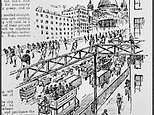1898 magazine depiction of how London will look is ‘scarily accurate’
Magazine sketch from 1898 predicting how London would look in 1998 is praised for ‘impressive accuracy’ – from cycle lanes and buses on roads surrounded by blocks of flats (pity the flying taxis never arrived)
Charlotte Hume, from Kensington Olympia, London, shared a pictured from Pearson’s Weekly to her popular Twitter account Back in Time West LondonSketch shows London broken up with bus and cycle lanes and roller bladersText accompanying the image reads that ‘there will not be stairs, lifts will dominate’ and that ‘most people will live in flats’
<!–
<!–
<!–<!–
<!–
(function (src, d, tag){
var s = d.createElement(tag), prev = d.getElementsByTagName(tag)[0];
s.src = src;
prev.parentNode.insertBefore(s, prev);
}(“https://www.dailymail.co.uk/static/gunther/1.17.0/async_bundle–.js”, document, “script”));
<!–
DM.loadCSS(“https://www.dailymail.co.uk/static/gunther/gunther-2159/video_bundle–.css”);
<!–
A 1898 magazine’s cartoon depicting what London would look like in 1998 has been praised for being ‘impressively accurate’ after it was shared online by a viral history account.
Charlotte Hume, from Kensington Olympia, London, shared a pictured from Pearson’s Weekly to her Twitter account Back in Time West London.
The pencil sketch shows London broken up with bus and cycle lanes, many people travelling on open top bus, with modern architecture and St Paul’s in sight.
Text accompanying the image reads that ‘there will not be stairs, lifts will dominate’ and that ‘most people will live in flats’.
However, the sketch also shows many people commuting on rollerskates, which was not a common form of transport in 1998.
Elsewhere, a flying blimp, that could be used to transport passengers, was also wide off the mark.
Charlotte Hume, from Kensington Olympia, London, shared a pictured from Pearson’s Weekly to her Twitter account Back in Time West London.
No blimps or rollerblades but plenty of buses: A modern day picture of London shows how pedestrian and bus travel is common but rollerblading isn’t
‘“How London will look in 1998”. (Pearson’s Weekly, 1898),’ Charlotte wrote.
‘Cycle lane, Rollerblades (missed out on electric scooters), Lots of buses, Planes, St Pauls still visible, Raised walkways (Barbican only). That’s impressive,’ one history fan wrote.
Another added: ‘They got depressing, boxy architecture down frighteningly well.
‘Pretty much predicted the horror that is new London vernacular architecture. strong prediction work,’ said a third.
‘Not a bad guess really,’ added another.
Many people quickly responded to the image sharing how it was ‘impressively accurate’ while others pointed out things they may have got wrong including most people travelling on roller skates and advertising being via blimps.
While many elements were accurate some missed the mark.
All pedestrians in the photo are travelling by rollerblade, while a blimp is being used to advertise in the sky.
‘Possibly a tad over emphasising the importance of the roller skate,’ said one.
‘Wildly underestimated the rise of the private car,’ added another.
‘Funny that the people who put this together couldn’t envisage that buses would have fully enclosed top decks by 1998,’ joked a third.
St Paul’s – which is visible in the picture- is a protected view in London. The system was first introduced in 1938 and ensures that views of historical buildings like St Paul’s Cathedral and the Palace of Westminster can be seen from eight of the ‘sightlines’ across London.
There are around 730,000 bike journeys a day in London and nearly 10,000 buses in operation daily.
Pearson’s Weekly was a British weekly magazine that was printed from 1890 to 1939.
![]()


